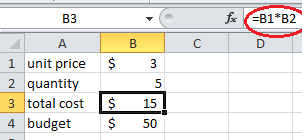Excel - NPV function
NPV function calculates the net present value of a future positive or negative cash flows. For example, suppose you will receive an income of $100 one year later, how much does it worth today?
$100 received one year later worth less than $100 received today. Because if you have $100 in hand at this moment and invest it, suppose the return rate is 5%, then it will grow into $105 one year later.
Next, we will show you how to calculate the net prevent value of $100 received one year later. Let the net prevent value of $100 received one year later be X, and suppose the investment return rate is 5%. Then
X*(1+0.05)=$100
So, X=$100/(1+0.05)=$95.24
It means that if you have $95.25 in hand right now and invest it with 5% investment return, it will grow into $100 one year later. Therefore, $100 received one year later is worth $95.24 today. That is to say, the net prevent value (NPV) of $100 received one year later is $95.24.
If you use NPV function, the formula is:
=NPV(0.05, 100)
What is the value of $100 received 3 years later? In the following figure it shows the NPV of $100 received 3 years later is $86.38. In math, it is calculated as 100/(1.05*1.05*1.05). The formula is:
=NPV(B1, B2:B4)
Now let's consider a slightly more complex scenario. Suppose the income is $20 in year 1, $50 in year 2, and $80 in year 3. What is the NPV of this series of cash flow? The formula is same. Only the numbers changed.
=NPV(B1, B2:B4)
Now suppose you need to invest $100 now to gain these future cash flows. What is the net present value (NPV) of this investment? We need to add the initial cost of investment into the calculation. Note the initial cost of investment is negative 100.
$100 received one year later worth less than $100 received today. Because if you have $100 in hand at this moment and invest it, suppose the return rate is 5%, then it will grow into $105 one year later.
Next, we will show you how to calculate the net prevent value of $100 received one year later. Let the net prevent value of $100 received one year later be X, and suppose the investment return rate is 5%. Then
X*(1+0.05)=$100
So, X=$100/(1+0.05)=$95.24
It means that if you have $95.25 in hand right now and invest it with 5% investment return, it will grow into $100 one year later. Therefore, $100 received one year later is worth $95.24 today. That is to say, the net prevent value (NPV) of $100 received one year later is $95.24.
If you use NPV function, the formula is:
=NPV(0.05, 100)
What is the value of $100 received 3 years later? In the following figure it shows the NPV of $100 received 3 years later is $86.38. In math, it is calculated as 100/(1.05*1.05*1.05). The formula is:
=NPV(B1, B2:B4)
Now let's consider a slightly more complex scenario. Suppose the income is $20 in year 1, $50 in year 2, and $80 in year 3. What is the NPV of this series of cash flow? The formula is same. Only the numbers changed.
=NPV(B1, B2:B4)
The NPV is $31.91. It means this investment brings a positive rate of return.
If the initial cost of investment is not $100, but $140. The NPV will be -$6.18. It means you will lose money on this investment.
Now suppose the initial cost of investment is still $100, but you need to make extra $28 investment in year 2. How to calculate the NPV? Since the original cash flow in year 2 is 50, but now you need to make extra investment in year 2, the net cash flow for year 2 is $50-$22=$28. Like below:









Comments
Post a Comment